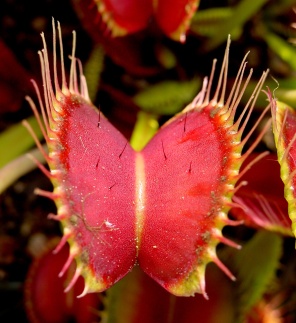If you think plants weren’t smart then you would be wrong.
Counting numbers is something we do on a regular basis, how much change for a cup of coffee, calculating how much time we have between meetings, counting the number of days until payday.
But imagine if you had to count numbers so that you could eat. Venus flytraps (Dionaea muscipula) do just that. A group in Germany led by Jennifer Böhm and Rainer Hedrich recently published a paper looking at the mechanism behind mealtime for the popular carnivorous plant. What they really wanted to know was how did the venus flytrap know when to kick-start the glands that produced the digestive juices once its prey had been trapped. What was the mechanism responsible for this?
In areas of infertile, nutrient-poor soils, carnivorous plants thrive. The reason? They feed solely on insects and other small animals. The anatomy of a venus flytrap is pretty simple, yet does a very effective job at capturing and digesting flesh. The trap itself is actually a modified leaf, with a hinged middle, which would act like the central vein of a normal leaf. The edges of the modified leaf (trap) end in spikes which interlock with each other when the trap closes.

A carnivorous beauty. Tiny hairs are present on the inner surface of the trap. Touching these stimulate action potentials which trigger the trap to close and produce digestive juices (Photo credit).
A starving flytrap will release a smell much like a fruity cocktail. This attracts numerous insects and small animals (frogs have even been known to succumb to the venus flytrap). When an unsuspecting fly lands on the trap, its movement triggers tiny hairs present on the inner epidermis of the trap.

A wasp caught in the hinges (Photo credit).
These hairs then convert the mechanical stimulation to an electrical excitation, otherwise known as an action potential. The trap shuts once two action potentials have been fired within approximately 30 seconds, caging in the insect. As the trapped insect continues to struggle, inevitably more hairs are triggered. As many as 60 action potentials per hour can be fired. Böhm and her group observed that after 3 action potentials were fired, the level of calcium within the cytoplasm (of the plant cells) increased. This then stimulated the expression of the touch hormone jasmonic acid. The jasmonic acid signalling pathway is usually used as a defense mechanism in a non-carnivorous plant when it is wounded. However, in carnivorous plants, the pathway stimulates the production of digestive enzymes by switching on certain transcription factors (proteins that control gene activity). Effectively, the closed trap turns into a green stomach and the insect is mercilessly broken down into its basic molecules, e.g. carbon, nitrogen, phosphorus etc., which are absorbed by glands in the trap. Also, digestion of prey increases production of a specific transporter which allows for greater uptake of sodium, which in turn is important in regulating the nutrient uptake channels found in the glands. The group also noted that the flytrap seemed to regulate the amount of digestive juices secreted into the trap by how many action potentials had been fired. The flytrap could potentially use this as a clue to the size of its prey, so it wouldn’t over-flood its trap therefore conserving as much energy as possible.
More research is going into sequencing the genome of the venus flytrap to understand how these carnivorous traits have developed, and how they can thrive in nutrient-poor environments. Maybe from that we can take what information we know about nutrient uptake in carnivorous plants and transfer that to other plants. Or do we risk creating Frankenstein plants?
Who knows. All I know is that you won’t find out if you don’t try.
#tryscience
Link to journal paper:
Böhm J., Scherzer S., Krol E., Kreuzer I., von Meyer K., Lorey C., Mueller T. D., Shabala L., Monte I., Solano R., Al-Rasheid K. A. S., Rennenberg H., Shabala S., Neher E. and Hedrich R. (2016) The venus flytrap Dionaea muscipula counts prey-induced action potentials to induce sodium uptake. Current Biology 26, 286-295
http://www.sciencedirect.com/science/article/pii/S0960982215015018


